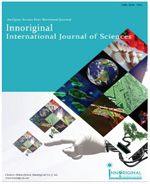Effects of Ozone on Egg Shell Microbial Load, Hatching Traits and Chick Performance in Quail Eggs
Abstract
Objective: The aim of this study was to establish the effects of ozone on eggshell total aerobic mesophilic bacteria, egg weight loss, hatching traits, embryo deaths and chick performance. Methods: A total of 825 fresh hatching quail eggs were randomly distributed into five groups. Treatment groups were formed as control group (benzalkonium cloride application; C), 1% ozone application (O1), 3% ozone application (O3), 5% ozone application (O5) and 7% ozone application (O7). Results: There were no significant differences between the groups in terms of egg weight loss, hatching traits, embryo deaths, chick performance and livability. Ozone treatment had lower levels of total bacteria, especially in O7 group, than control eggs for the entire incubation period. Conclusion: As a result, the application of ozone can be used as an alternative to natural chemical disinfectant without adversely affecting the incubation results and chick performance.References
Williams J. Effect of high-level formaldehyde fumigation on bacterial populations on the surface of chicken hatching eggs. Avian Diseases 1970: 386-392.
Berrang M, Cox N, Frank J, Buhr R. Bacterial penetration of the eggshell and shell membranes of the chicken hatching egg: a review. Journal of Applied Poultry Research 1999; 8 (4): 499-504.
Aygun A, Sert D. Effects of prestorage application of propolis and storage time on eggshell microbial activity, hatchability, and chick performance in Japanese quail (Coturnix coturnix japonica) eggs. Poultry science Article 2013; 92 (12): 3330-3337. doi: 10.3382/ps.2013-03291.
Aygun A, Sert D, Copur G. Effects of propolis on eggshell microbial activity, hatchability, and chick performance in Japanese quail (Coturnix coturnix japonica) eggs. Poultry science Article 2012; 91 (4): 1018-1025. doi: 10.3382/ps.2011-01944.
Bocci VA. Scientific and medical aspects of ozone therapy. State of the art. Archives of medical research 2006; 37 (4): 425-435.
Nogales CG, Ferrari PH, Kantorovich EO, Lage-Marques J. Ozone therapy in medicine and dentistry. J Contemp Dent Pract 2008; 9 (4): 75-84.
Özden Ö, Başaran F, Muhtaroğlu G. Akuakültürde yeni bir uygulama: Ozon teknolojisi. Aquaculture and Fisheries 2006: 22-28.
Bailey J, Buhr R, Cox N, Berrang M. Effect of hatching cabinet sanitation treatments on Salmonella cross-contamination and hatchability of broiler eggs. Poultry science 1996; 75 (2): 191-196.
Braun P, Fernandez N, Fuhrmann H. Investigations on the Effect of Ozone as a Disinfectant of Egg Surfaces. Ozone: Science & Engineering 2011; 33 (5): 374-378.
Choi G-H, Lee K-H. Effect of ozone treatment for sanitation of egg. Korean Journal for Food Science of Animal Resources 2012; 32 (2): 198-203.
Aygun A, Sert D. Effects of ultrasonic treatment on eggshell microbial activity, hatchability, tibia mineral content, and chick performance in Japanese quail (Coturnix coturnix japonica) eggs. Poultry science 2012; 91 (3): 732-738. doi: 10.3382/ps.2011-01901.
Sert D, Aygun A, Torlak E, Mercan E. Effect of ultrasonic treatment on reduction of Esherichia coli ATCC 25922 and egg quality parameters in experimentally contaminated hens' shell eggs. Journal of the Science of Food and Agriculture 2013; 93 (12): 2973-2978.
Whistler P, Sheldon B. Bactericidal activity, eggshell conductance, and hatchability effects of ozone versus formaldehyde disinfection. Poultry science 1989; 68 (8): 1074-1077.
Rodriguez-Romo LA, Yousef AE. Inactivation of Salmonella enterica serovar Enteritidis on shell eggs by ozone and UV radiation. Journal of Food Protection 2005; 68 (4): 711-717.
Romao J, Moraes T, Teixeira R, Cardoso W, Buxade C. Effect of egg storage length on hatchability and weight loss in incubation of egg and meat type Japanese quails. Revista Brasileira de Ciência AvÃcola 2008; 10 (3): 143-147.
Nowaczewski S, Kontecka H, Rosiński A. Effect of Japanese quail eggs location in the setter on their weight loss and eggshell temperature during incubation as well as hatchability results. Arch Geflügelk 2012; 76: 168-175.
Peebles ED, Pansky T, Doyle SM, Boyle CR, Smith T, Latour MA, et al. Effects of dietary fat and eggshell cuticle removal on egg water loss and embryo growth in broiler hatching eggs. Poultry science 1998; 77 (10): 1522-1530.
Geng Z, Wang X. Relationship of hatchability and the percentage of egg weight loss and shell pore concentration during incubation. Chin J Anim Sci 1990; 26: 12-14.
Mo D, Li K, Qiangba Y, Tang X, Zhu M, Xu R, et al. Effect of mating combination and environmental factors on hatchability of chicken eggs in Tibet. Frontiers of Agriculture in China 2007; 1 (2): 214-219.
Fuhrmann H, Rupp N, Büchner A, Braun P. The effect of gaseous ozone treatment on egg components. Journal of the Science of Food and Agriculture 2010; 90 (4): 593-598.
Yildirim I, Ozcan M. Use of oregano and cumin essential oils as disinfectant on hatching quail eggs. Journal of Animal Research Institute 2001; 11 (2): 61-63.
Copur G, Arslan M, Duru M, Baylan M, Canogullari S, Aksan E. Use of oregano (Origanum onites L.) essential oil as hatching egg disinfectant. African Journal of Biotechnology 2010; 9 (17): 2531-2538.
Fasenko G, Christopher EOD, McMullen L. Spraying hatching eggs with electrolyzed oxidizing water reduces eggshell microbial load without compromising broiler production parameters. Poultry science 2009; 88 (5): 1121-1127.
Cadirci S. The effect of fumigation regimens on shell structure and embryo viability. M. Sc. Thesis, University of Glasgow, 1997.
Downloads
Published
How to Cite
Issue
Section
License
Copyright (c) 2021 Innoriginal:International Journal Of Sciences

This work is licensed under a Creative Commons Attribution-NonCommercial 4.0 International License.


